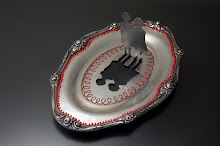A few years ago I did
a little post about when I made shibuichi for the first time. My friend
Victoria Altepeter taught me how to make it. I get tons of hits on this post and tons of people are directed to my blog when they do a google keyword search for "shibuichi". I have google analytics, which is how I know how people find my blog. Its a cool and creepy thing.
Anyway, I thought since I get so much traffic to my blog from people looking to learn how to make shibuichi, that I should do a more detailed post on the matter. So, here we go.
How to make your own shibiuichi!
Shibuichi is a Japanese alloy of silver and copper. It can range anywhere between 5% silver to 50% silver with the rest being copper. Shibuichi is a beautiful pinkish white metal that can take a wide range of patinas to change to many colors from blues and greens to deep reds and oranges. It works wonderfully, reticulates to amazing textures, and casts well. Oh, and because of its high copper content, its cheaper than sterling! I prefer a 70-80% copper and 20-30% silver alloy.
First you need to decide what precentage you want your alloy to be. Once you have determined that, cut your scrap metal into small pieces and weigh it out (separately by metal). Keep in mind that if you are using sterling instead of fine silver you have to account for the fact that sterling already is 7.5% copper.
Your next step is to decide what kind of ingot you are going to pour (sheet or wire). Then make sure you carbon coat the ingot so your metal will not stick to it. Do this by lighting just the gas on your oxy/acetylene torch and running the flame over your ingot mold. The smoke that comes off the gas only flame is dark dirty and will totally coat your mold in carbon.
See how black it is?
Then its time to preheat your crucible. Make sure your crucible is large enough to hold the amount of metal you are going to pour. You should have a crucible designated just for shibuichi (although depending on your alloy, it may be ok to use your sterling crucible). This is so you do not cross contaminate your metals. Light your torch and heat up your crucible until it is slightly glowing with heat. Also make sure to give it a coating of flux (borax). Make sure you always wear protective eyewear when working with the torch, and other appropriate safety gear.

Now you are ready to start melting metal. This is where it gets fun! I always start with my higher melting temperature metal first (so in this case, copper). Put your CLEAN copper scraps into the crucible and heat with the torch until they are completely molten to a liquid state. Then add your silver and heat until it is melted. Add a little more borax and scrape any junk off the surface of your liquid metal. Make sure to stir with a carbon rod so you know the metal is completely molten.
When all your metal is liquified, you are ready to pour into your ingot. This takes coordination and practice. I am not coordinated and almost always spill some out. Luckily any spills are recoverable!
Try to pour continuously and quickly. If you go to slow or have breaks, you may not end up with one solid piece when it cools.
Wait until the metal is no longer red hot before opening the ingot mold, or taking your metal out (depending on which type of mold you are using). Then you can open it up, take the metal out, quench in water and then pickle.
After pickling I take my ingot to the belt sander and grind off any sharp edges or flashing. When rolling your metal down in the rolling mill these sharp edges can cause cracks. If you do see any cracks when rolling out your metal, make sure to grind them completely away right away, otherwise they will just get bigger and bigger each time you feed your metal through the rolling mill.
As you can see from the picture below, I poured too slowly and got a separation of the metal in my ingot. This part needs to be cut off or it will just crack.
After grinding and rounding all edges, you are ready to mill your metal down to whatever form you want it in (sheet or wire). You don't have to anneal yet, because when pouring the ingot the metal definitely reached annealing temperature! Set your rolling mill for the thickness of your ingot, and then tighten just slightly. You dont want to force the metal too fast. Each time you feed your metal through the rollers, you can tighten them down a little. All mills are different, but I usually tighten between and eighth and a quarter of a turn.
Once you feel more resistance, its time to anneal. I usually only roll my ingot through the mill 4-5 times before annealing. Just keep annealing and running it through the mill until you get the thickness that you want!
And here is a picture of the shibuichi I rolled out and then reticulated.
Now you can see how easy it is to make your own shibuichi. Have fun!
![]()
![]()
![]()
![]()
![]()
![]()
![]()
![]()























